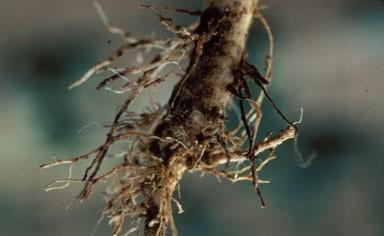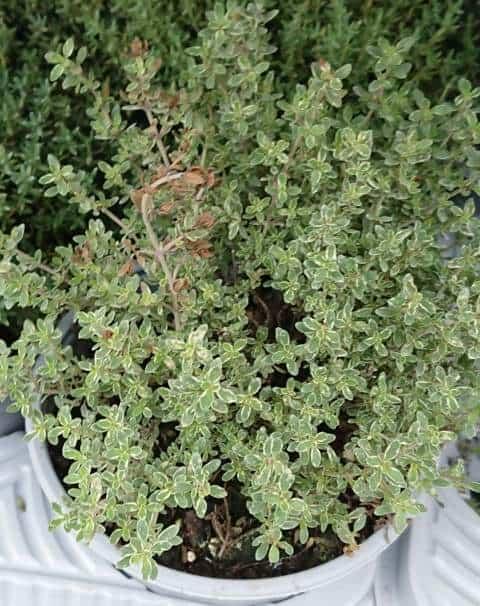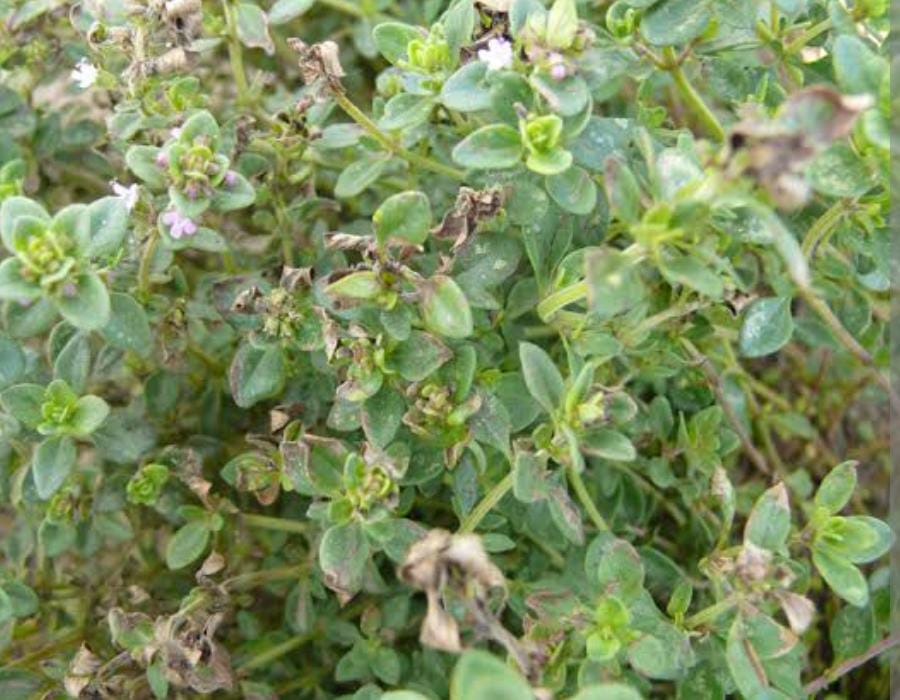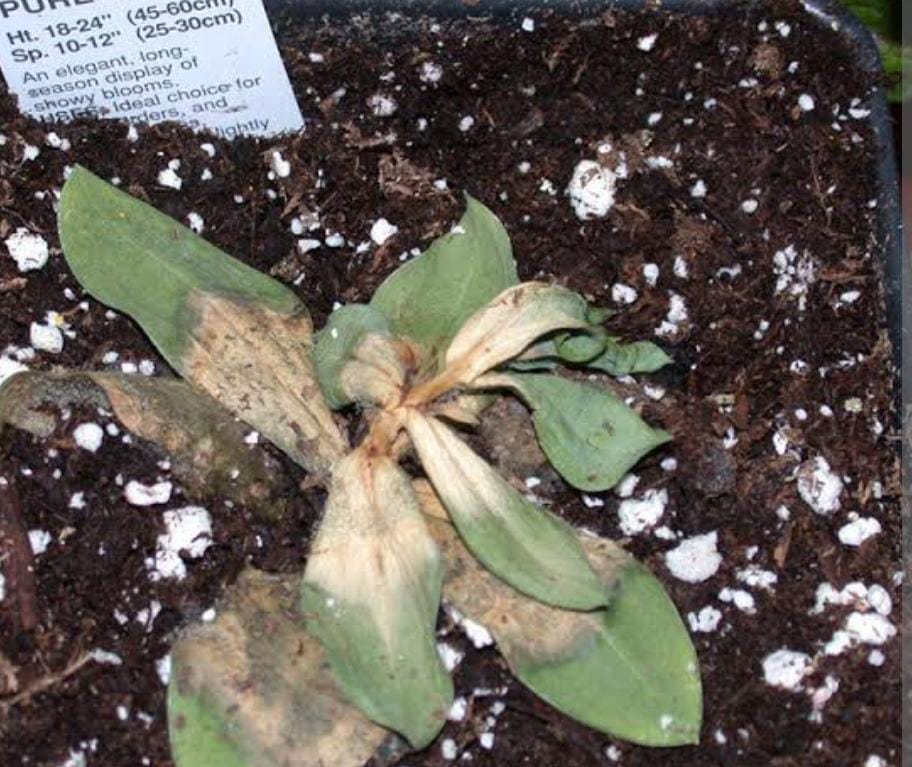Thyme Plant
Thyme is a perennial, 6-12 inches tall, and frost-tolerant. It prefers well-drained, sandy-loam soil in full sun. Keep the soil moist. Thyme is both edible and has medicinal properties.

Habit
Perennial
Height
0.2 to 0.3 m
Growth
slow
Soil
Well-drained, Sandy Loam
Shade
Full Sun
Moisture
Moist
Edible
Yes
Medicinal
Yes
Origin
Mediterranean, Europe
Climatic Condition
Subtropical, Temperate
Temperature (°)
15°C to 25°C
Humidity (%)
50% to 60%
Potting media
50% Loam, 40% Sand, 10% Compost
Fertilizers
Organic Fertilizer
Watering
Regular watering
Plant Weight
0.2 to 0.3 kg
Flowering Time
Spring to Summer
Soil Ph level
6.0 to 7.0
Water Ph level
6.0 to 7.0
Soil EC
0.5 to 0.8 mS/cm
Yield Per Plant
1 to 2 kg per plant
NPK ratio
05:10:10
life Span
2 to 3 years
Health Benefits
Medicinal, Antioxidant
Suggested Grow Media or Potting Mix ?
50% compost, 30% perlite, 20% coarse sand
Suggested Fertigation/Fertilizers
Fertilize every 4-6 weeks with a balanced, water-soluble fertilizer.
Common Diseases and Remedies
Botrytis root rot , Alternaria blight
Rotted areas are soft and mushy, becoming leathery and dry in the absence of high humidity , Yellow, brown or black spots, often with concentric rings
Neem oil , Shredding leaf litter .
What is the Thyme Plant?
Thyme (Thymus vulgaris) is a versatile, aromatic herb that belongs to the Lamiaceae family (Lamiaceae). This plant is native to the Mediterranean region, but is now cultivated all over the world for food, medicinal, and ornamental purposes. This perennial herb usually grows low to the ground and has small, grey-green leaves that give off a strong earthy scent when squeezed
What types of thyme plants are there?
1. *Common Thyme (Thymus vulgaris):*
This is a standard thyme variety known for its strong, earthy flavor and gray-green leaves. It is often used in cooking and Chinese medicine.
2. *Lemon Thyme (Thymus citriodorus):*
As the name suggests, this type of thyme has a distinct lemon taste and aroma and is popular for adding lemon flavor to dishes.
3. *Creeping Thyme (Thymus serpyllum):*
Also called Mother Thyme or Wild Thyme. This low-growing variety forms a dense mat of leaves and produces small pink or purple flowers. It is often used as a ground cover in rock gardens and between stepping stones.
4. *Orange Thyme (Thymus fragrantissimus):*
This variety of thyme has a hint of orange in its taste and aroma, adding a unique touch to dishes.
5. *Silver Thyme (Thymus vulgaris 'Argenteus'):*
Silver thyme has bright silver and green leaves that add visual interest to gardens and landscapes. It tastes similar to regular thyme, but with a slightly milder flavor.
How do you care for your thyme?
Location
Place your thyme plant in a location that receives plenty of sunlight, preferably at least 6 to 8 hours of direct sunlight per day. It grows in It also prefers well-drained soil that is not too rich in nutrients. Well-drained sandy or rocky soils are best for growing thyme.
Climatically, thyme plants prefer warm to warm climates and can tolerate a wide range of temperatures. However, it may struggle in very humid or wet conditions, as excessive moisture can cause root rot and other problems.
Thyme can be grown in beds or containers, making it suitable for a variety of garden designs. If planting in a pot, be sure to make drainage holes to prevent water from seeping in.
Overall, thyme plants thrive in full sunlight, well-drained soil, and moderate temperatures, making them suitable for growing in a variety of climates and environments.
Sunlight
Thyme plants need lots of sunlight to grow. Ideally, it should be exposed to direct sunlight for at least 6 to 8 hours a day. Too little sunlight can weaken leaf growth and reduce flavor. Therefore, to ensure healthy growth and fragrant foliage, it is important to plant thyme in a location that receives full sunlight.
Soil
Thyme plants prefer well-drained soil that is not too rich in nutrients. Grows in well-drained sandy or rocky areas. Slightly alkaline soil with a pH between 6.0 and 8.0 is ideal for growing thyme.
To improve drainage, you can mix sand or perlite into the soil or pot when planting thyme. Additionally, avoid heavy clay soils, which tend to retain moisture, as this can cause root rot and other problems for thyme plants.
Overall, providing well-drained soil with moderate fertility helps ensure the health and vigor of thyme plants.
Hydration
Thyme plants prefer moderate humidity and well-drained soil. Once established, it is relatively drought tolerant and does not like to sit in moist soil. Allow the soil to dry out a little between waterings, then water thoroughly.
Nourishment
Thyme plants have low nutritional requirements and generally grow in poor soils. Too much fertilizer will keep the leaves lush and lush, but it can affect the flavor of the leaves. Therefore, when planting thyme, it is best to avoid fertile or heavily amended soils.
Issues
Although thyme plants are relatively resilient, they can still face a few problems:
1. *Overwatering:* Thyme plants cannot be grown if the soil is constantly watered. If it is saturated, it will be more prone to root rot. To prevent this, ensure good drainage of the soil, water the plant moderately, and allow the soil to dry slightly between waterings.
2. *Pests:* Thyme is not usually susceptible to serious pest infestations, but it may attract pests such as aphids, spider mites, and thrips. Inspect plants regularly for signs of pests and use organic insecticidal soap or neem oil as needed to control infestations.
3. *Diseases:* Thyme plants can be susceptible to fungal diseases such as powdery mildew and root rot, especially in damp or poorly ventilated conditions. To prevent the spread of disease, avoid overhead watering, ensure good air circulation around the plant, and remove infected leaves immediately.
What are the benefits of the thyme plant?
Thyme is known for its numerous benefits, including:
1. *Antibacterial properties:* Thyme contains compounds such as thymol and carvacrol, which have strong antibacterial properties. It helps fight various bacteria and fungi, thereby having a positive effect on the health of the immune system and the fight against infections.
2. *Antioxidant properties:* Thyme is rich in antioxidants such as flavonoids, phenolic compounds, and vitamins such as vitamin C. These antioxidants help neutralize free radicals in the body, reduce oxidative stress, and reduce the risk of chronic disease.
3. *Respiratory Support:* Thyme has long been used as a natural treatment for respiratory illnesses such as coughs, colds, and bronchitis. Its expectorant properties loosen mucus and congestion, making it easier to expel mucus and reducing breathing difficulties.
4. *Digestive Benefits:* Thyme is known to stimulate digestion and reduce gastrointestinal problems such as gas, bloating, and indigestion. It also helps relieve stomach cramps and promotes overall digestive health.
5. *Anti-inflammatory benefits:* Thyme contains anti-inflammatory compounds that reduce inflammation in the body and relieve symptoms of inflammatory diseases such as arthritis and inflammatory bowel disease.
Frequently asked questions about growing thyme plants?
How do you care for thyme?
Caring for thyme is relatively easy. Here are some tips to keep you healthy and thriving:
1. *Sunlight:* Make sure your thyme plant receives enough sunlight. Ideally, it should receive 6 to 8 hours of direct sunlight per day. Place it in a sunny spot in your garden or on a sunny windowsill if growing indoors.
2. *Watering:* Thyme prefers moderate humidity and well-drained soil. Water the plant when the soil feels dry. However, be careful not to overwater as this may cause root rot. Allow the soil to dry slightly between waterings.
3. *Soil:* Plant thyme in well-drained soil that is not too rich in nutrients. Well-drained sandy or stony soils are ideal. Avoid heavy clay soils that retain moisture as this can cause problems for thyme plants.
What is the purpose of the thyme plant?
Thyme is a versatile herb with a variety of uses including:
1. *Cooking:* Thyme is an important ingredient in many cuisines around the world. Its bold, earthy flavor adds depth to a variety of dishes, including meats (chicken, lamb, beef, etc.), vegetables, soups, stews, sauces, marinades, and dressings. It pairs well with other herbs such as rosemary, sage, and oregano to enhance the overall flavor of the dish.
2. *Medicinal Uses:* Thyme has long been used in traditional medicine for its diverse health benefits. It contains compounds with antibacterial, antifungal, antioxidant, and anti-inflammatory properties that are beneficial for immune system health, treating respiratory diseases, digestion, reducing inflammation, and promoting overall health.
3. *Aromatherapy:* Thyme essential oil is used in aromatherapy for its calming, uplifting, and purifying effects.
Can I grow thyme plants indoors?
Yes, you can grow thyme indoors, especially if you have a sunny window or bright area in your house. Masu. Here are some tips for growing thyme indoors:
1. *Sunlight:* Thyme plants need lots of sunlight. Therefore, choose a location that can receive at least 6-8 hours of direct sunlight per day. Typically, a south-facing window is best for growing thyme indoors.
2. *Container:* Plant thyme in a well-draining container with drainage holes to avoid waterlogging. Terracotta pots are a good choice as they allow good air circulation to the roots. Make sure the container is large enough to accommodate the plant's root system and give it room to grow.
3. *Soil:* For herbs and succulents, use well-drained potting soil. You can also mix in sand or perlite to improve drainage. Avoid heavy soils with high moisture content as this can cause root rot.
4. *Water:* Water your thyme plant when the top of the soil feels dry. Water thoroughly, drain excess water and empty the saucer to avoid waterlogging. Thyme is prone to root rot, so be careful not to overwater.
Which pot is best for growing a thyme plant?
When choosing a pot for growing a thyme plant, to ensure the best growth and health of the plant , consider the following factors:
1. *Drainage:* Choose a pot with drainage holes in the bottom to drain excess water. This is to let water escape. Thyme plants prefer well-drained soil, and if the roots are submerged in water, it can cause rot and other problems.
2. *Size:* Choose a pot large enough to accommodate the thyme plant's root system and give it room to grow. If the pot is too small, root growth will be stunted and you may need to water more frequently.
3. *Materials:* Terracotta pots are a popular choice for growing thyme as they allow better air circulation to the roots and help drain excess moisture from the soil. However, you can also use plastic, ceramic, or other materials as long as they have drainage holes.
Where can I buy thyme plants?
Thyme plants can be purchased from a variety of places, including
1. *Nurseries and Garden Centers:* Local nurseries and garden centers often carry a variety of herbal plants, including thyme. Visit your local nursery or garden center, browse the selection, and choose a healthy thyme plant.
2. *Hardware stores:* Many hardware stores, such as Home Depot, Lowe's, and Walmart, have garden departments where you can find herbal plants such as thyme. Check out thyme plants in pots and containers at these store nurseries3. *Online Retailers:* You can also purchase thyme plants from online retailers such as Amazon, Etsy, and specialty herb nurseries. Look for trusted sellers with positive reviews and choose plants that are healthy and shipped with care so they're ready to plant.
4. *Farmer's Market:* Your local farmers market may also have vendors selling herbal plants such as thyme. Visit your local farmers market and see if they have a retail store that sells thyme plants.



